FIAT FULLBACK 2016 1.G Owners Manual
Manufacturer: FIAT, Model Year: 2016, Model line: FULLBACK, Model: FIAT FULLBACK 2016 1.GPages: 312, PDF Size: 13.67 MB
Page 241 of 312
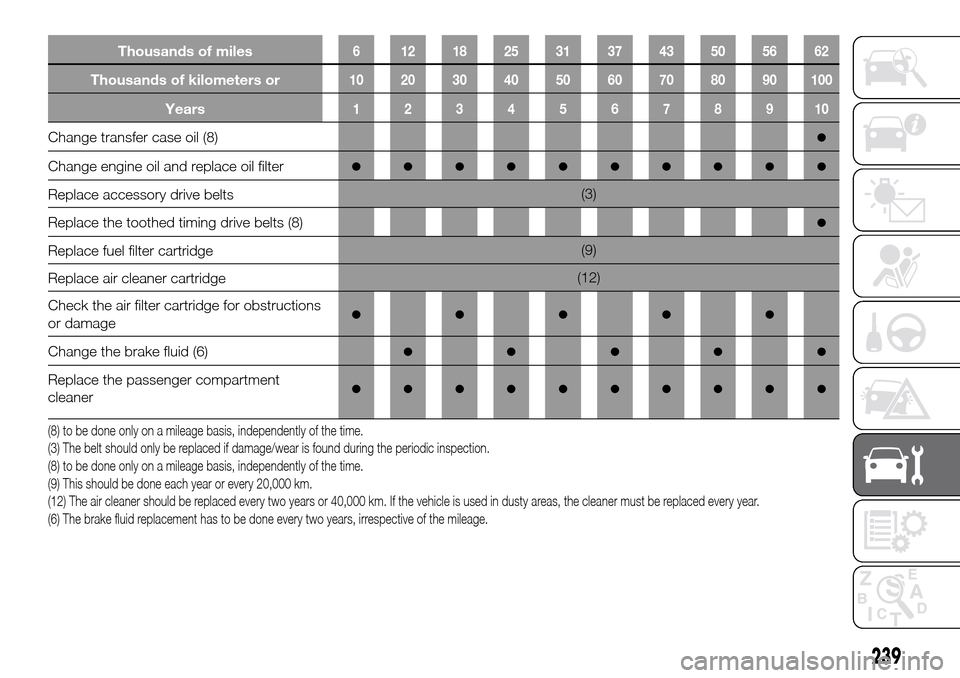
Thousands of miles6 121825313743505662
Thousands of kilometers or10 20 30 40 50 60 70 80 90 100
Years12345678910
Change transfer case oil (8)●
Change engine oil and replace oil filter●●●●●●●●●●
Replace accessory drive belts(3)
Replace the toothed timing drive belts (8)
●
Replace fuel filter cartridge(9)
Replace air cleaner cartridge(12)
Check the air filter cartridge for obstructions
or damage
●●●●●
Change the brake fluid (6)●●●●●
Replace the passenger compartment
cleaner●●●●●●●●●●
(8) to be done only on a mileage basis, independently of the time.
(3) The belt should only be replaced if damage/wear is found during the periodic inspection.
(8) to be done only on a mileage basis, independently of the time.
(9) This should be done each year or every 20,000 km.
(12) The air cleaner should be replaced every two years or 40,000 km. If the vehicle is used in dusty areas, the cleaner must be replaced every year.
(6) The brake fluid replacement has to be done every two years, irrespective of the mileage.
239
Page 242 of 312
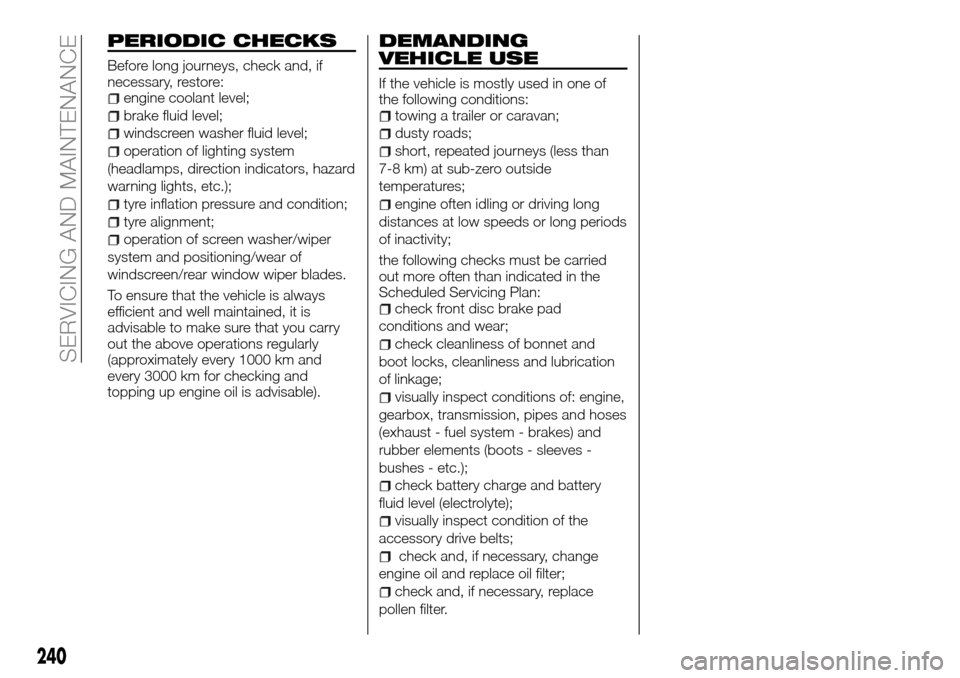
PERIODIC CHECKS
Before long journeys, check and, if
necessary, restore:
engine coolant level;
brake fluid level;
windscreen washer fluid level;
operation of lighting system
(headlamps, direction indicators, hazard
warning lights, etc.);
tyre inflation pressure and condition;
tyre alignment;
operation of screen washer/wiper
system and positioning/wear of
windscreen/rear window wiper blades.
To ensure that the vehicle is always
efficient and well maintained, it is
advisable to make sure that you carry
out the above operations regularly
(approximately every 1000 km and
every 3000 km for checking and
topping up engine oil is advisable).
DEMANDING
VEHICLE USE
If the vehicle is mostly used in one of
the following conditions:
towing a trailer or caravan;
dusty roads;
short, repeated journeys (less than
7-8 km) at sub-zero outside
temperatures;
engine often idling or driving long
distances at low speeds or long periods
of inactivity;
the following checks must be carried
out more often than indicated in the
Scheduled Servicing Plan:
check front disc brake pad
conditions and wear;
check cleanliness of bonnet and
boot locks, cleanliness and lubrication
of linkage;
visually inspect conditions of: engine,
gearbox, transmission, pipes and hoses
(exhaust - fuel system - brakes) and
rubber elements (boots - sleeves -
bushes - etc.);
check battery charge and battery
fluid level (electrolyte);
visually inspect condition of the
accessory drive belts;
check and, if necessary, change
engine oil and replace oil filter;
check and, if necessary, replace
pollen filter.
240
SERVICING AND MAINTENANCE
Page 243 of 312
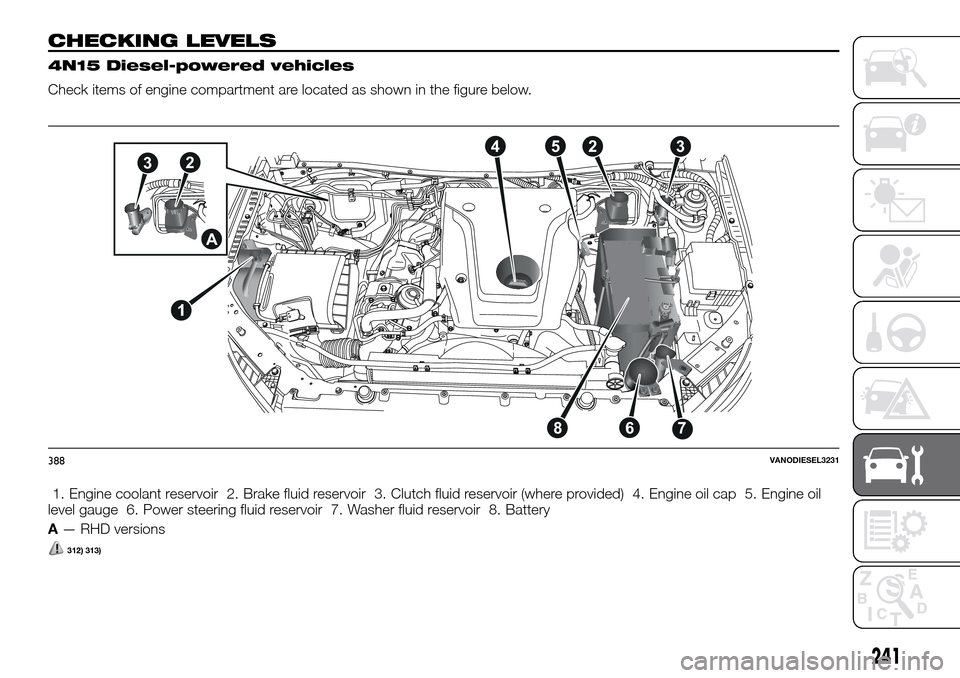
CHECKING LEVELS
4N15 Diesel-powered vehicles
Check items of engine compartment are located as shown in the figure below.
1. Engine coolant reservoir 2. Brake fluid reservoir 3. Clutch fluid reservoir (where provided) 4. Engine oil cap 5. Engine oil
level gauge 6. Power steering fluid reservoir 7. Washer fluid reservoir 8. Battery
A— RHD versions
312) 313)
A
1
42253
3
678
388VANODIESEL3231
241
Page 244 of 312
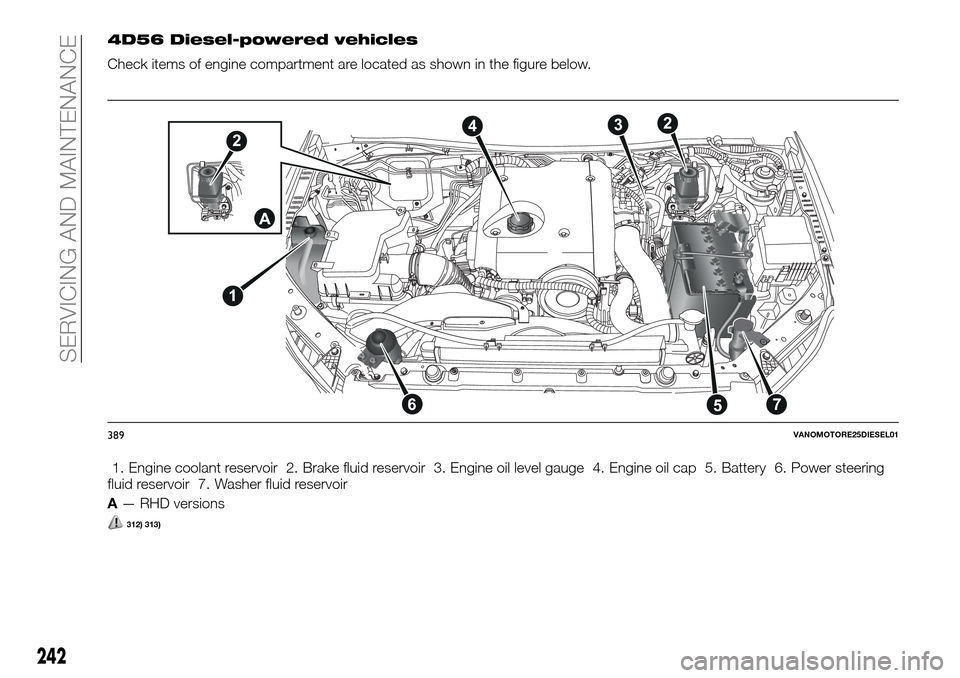
4D56 Diesel-powered vehicles
Check items of engine compartment are located as shown in the figure below.
1. Engine coolant reservoir 2. Brake fluid reservoir 3. Engine oil level gauge 4. Engine oil cap 5. Battery 6. Power steering
fluid reservoir 7. Washer fluid reservoir
A— RHD versions
312) 313)
1
42
23
756
A
389VANOMOTORE25DIESEL01
242
SERVICING AND MAINTENANCE
Page 245 of 312
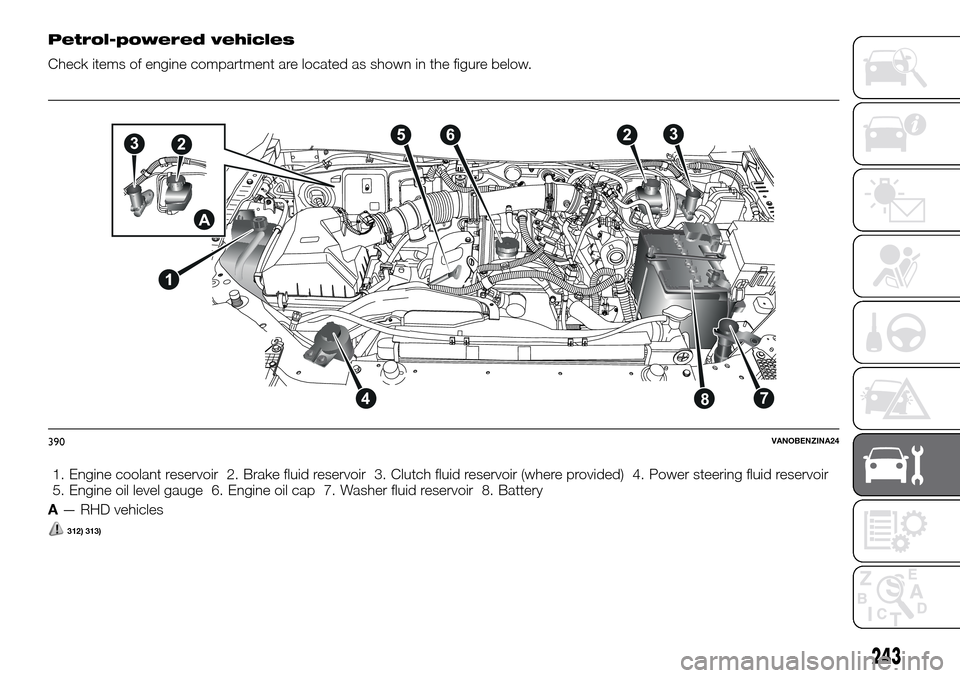
Petrol-powered vehicles
Check items of engine compartment are located as shown in the figure below.
1. Engine coolant reservoir 2. Brake fluid reservoir 3. Clutch fluid reservoir (where provided) 4. Power steering fluid reservoir
5. Engine oil level gauge 6. Engine oil cap 7. Washer fluid reservoir 8. Battery
A— RHD vehicles
312) 313)
1
623
784
5
A
23
390VANOBENZINA24
243
Page 246 of 312

WARNING
312)Never smoke when performing operations in the engine compartment. Flammable gases and fumes may be present and risk igniting.
313)Be very careful when working in the engine compartment when the engine is hot: you may get burned. Remember that the fan may start
up if the engine is hot: this could injure you. Scarves, ties and other loose clothing might be pulled by moving parts.
244
SERVICING AND MAINTENANCE
Page 247 of 312
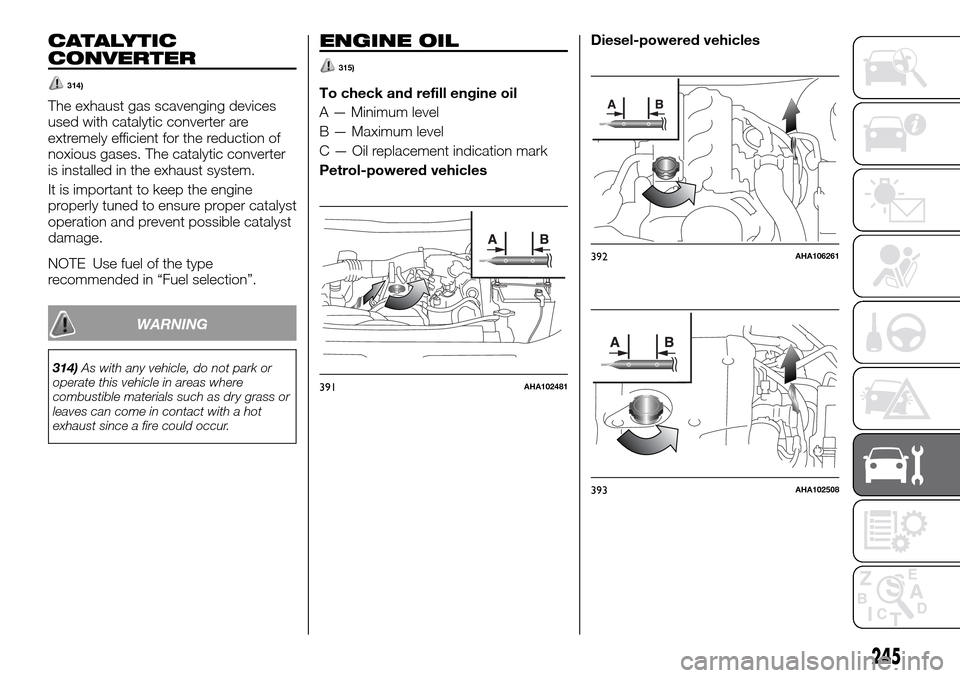
CATALYTIC
CONVERTER
314)
The exhaust gas scavenging devices
used with catalytic converter are
extremely efficient for the reduction of
noxious gases. The catalytic converter
is installed in the exhaust system.
It is important to keep the engine
properly tuned to ensure proper catalyst
operation and prevent possible catalyst
damage.
NOTE Use fuel of the type
recommended in “Fuel selection”.
WARNING
314)As with any vehicle, do not park or
operate this vehicle in areas where
combustible materials such as dry grass or
leaves can come in contact with a hot
exhaust since a fire could occur.
ENGINE OIL
315)
To check and refill engine oil
A — Minimum level
B — Maximum level
C — Oil replacement indication mark
Petrol-powered vehiclesDiesel-powered vehicles
391AHA102481
392AHA106261
393AHA102508
245
Page 248 of 312
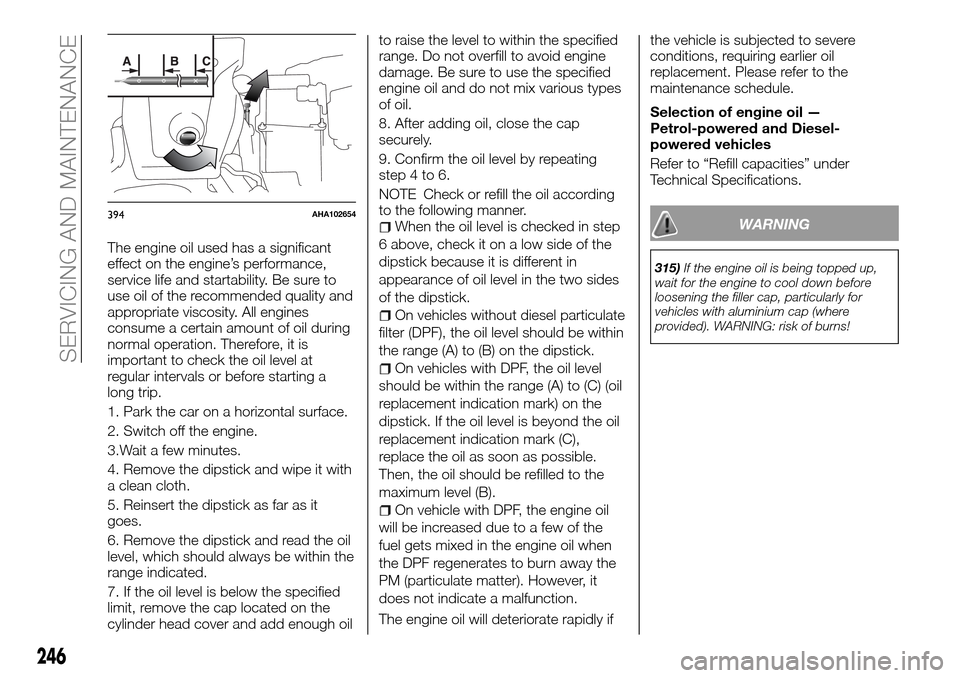
The engine oil used has a significant
effect on the engine’s performance,
service life and startability. Be sure to
use oil of the recommended quality and
appropriate viscosity. All engines
consume a certain amount of oil during
normal operation. Therefore, it is
important to check the oil level at
regular intervals or before starting a
long trip.
1. Park the car on a horizontal surface.
2. Switch off the engine.
3.Wait a few minutes.
4. Remove the dipstick and wipe it with
a clean cloth.
5. Reinsert the dipstick as far as it
goes.
6. Remove the dipstick and read the oil
level, which should always be within the
range indicated.
7. If the oil level is below the specified
limit, remove the cap located on the
cylinder head cover and add enough oilto raise the level to within the specified
range. Do not overfill to avoid engine
damage. Be sure to use the specified
engine oil and do not mix various types
of oil.
8. After adding oil, close the cap
securely.
9. Confirm the oil level by repeating
step 4 to 6.
NOTE Check or refill the oil according
to the following manner.
When the oil level is checked in step
6 above, check it on a low side of the
dipstick because it is different in
appearance of oil level in the two sides
of the dipstick.
On vehicles without diesel particulate
filter (DPF), the oil level should be within
the range (A) to (B) on the dipstick.
On vehicles with DPF, the oil level
should be within the range (A) to (C) (oil
replacement indication mark) on the
dipstick. If the oil level is beyond the oil
replacement indication mark (C),
replace the oil as soon as possible.
Then, the oil should be refilled to the
maximum level (B).
On vehicle with DPF, the engine oil
will be increased due to a few of the
fuel gets mixed in the engine oil when
the DPF regenerates to burn away the
PM (particulate matter). However, it
does not indicate a malfunction.
The engine oil will deteriorate rapidly ifthe vehicle is subjected to severe
conditions, requiring earlier oil
replacement. Please refer to the
maintenance schedule.
Selection of engine oil —
Petrol-powered and Diesel-
powered vehicles
Refer to “Refill capacities” under
Technical Specifications.
WARNING
315)If the engine oil is being topped up,
wait for the engine to cool down before
loosening the filler cap, particularly for
vehicles with aluminium cap (where
provided). WARNING: risk of burns!
394AHA102654
246
SERVICING AND MAINTENANCE
Page 249 of 312

ENGINE COOLANT
To check the coolant level
A transparent coolant reserve tank (A) is
located in the engine compartment. The
coolant level in this tank should be kept
between the “L” (LOW) and “F” (FULL)
marks when measured while the engine
is cold.
To add coolant
The cooling system is a closed system
and normally the loss of coolant should
be very slight. A noticeable drop in the
coolant level could indicate leakage. If
this occurs, we recommend you to
have the system checked as soon as
possible. If the level should drop below
the “L” (LOW) level on the reserve tank,
open the lid and add coolant.
Also, if the reserve tank is completely
empty, remove the radiator cap (B) andadd coolant until the level reaches the
filler neck.316)
Anti-freeze
The engine coolant contains an
ethylene glycol anti-corrosion agent.
Some parts of the engine are cast
aluminium alloy, and periodic changing
of the engine coolant is necessary to
prevent corrosion of these parts.
Use the recommended coolant by Fiat
or equivalent*. *: similar high quality
ethylene glycol based non-silicate,
non-amine, nonnitrate and nonborate
coolant with long life hybrid organic
acid technology Fiat genuine coolant
has excellent protection against
corrosion and rust formation of all
metals including aluminium and can
avoid blockages in the radiator, heater,
cylinder head, engine block, etc.
Because of the necessity of this
anti-corrosion agent, the coolant must
not be replaced with plain water even in
summer. The required concentration of
anti-freeze differs depending on the
expected ambient temperature.
148) 149) 150) 151)
FULL
LOW
A
B
395AHA105394
247
Page 250 of 312
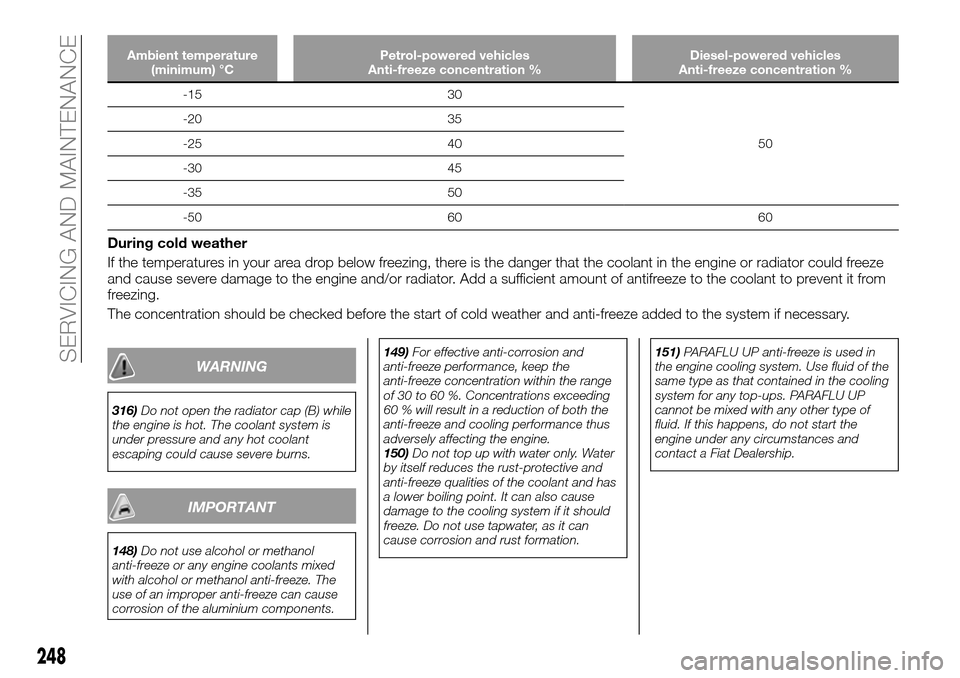
Ambient temperature
(minimum) °CPetrol-powered vehicles
Anti-freeze concentration %Diesel-powered vehicles
Anti-freeze concentration %
-15 30
50 -20 35
-25 40
-30 45
-35 50
-50 60 60
During cold weather
If the temperatures in your area drop below freezing, there is the danger that the coolant in the engine or radiator could freeze
and cause severe damage to the engine and/or radiator. Add a sufficient amount of antifreeze to the coolant to prevent it from
freezing.
The concentration should be checked before the start of cold weather and anti-freeze added to the system if necessary.
WARNING
316)Do not open the radiator cap (B) while
the engine is hot. The coolant system is
under pressure and any hot coolant
escaping could cause severe burns.
IMPORTANT
148)Do not use alcohol or methanol
anti-freeze or any engine coolants mixed
with alcohol or methanol anti-freeze. The
use of an improper anti-freeze can cause
corrosion of the aluminium components.149)For effective anti-corrosion and
anti-freeze performance, keep the
anti-freeze concentration within the range
of 30 to 60 %. Concentrations exceeding
60 % will result in a reduction of both the
anti-freeze and cooling performance thus
adversely affecting the engine.
150)Do not top up with water only. Water
by itself reduces the rust-protective and
anti-freeze qualities of the coolant and has
a lower boiling point. It can also cause
damage to the cooling system if it should
freeze. Do not use tapwater, as it can
cause corrosion and rust formation.151)PARAFLU UP anti-freeze is used in
the engine cooling system. Use fluid of the
same type as that contained in the cooling
system for any top-ups. PARAFLU UP
cannot be mixed with any other type of
fluid. If this happens, do not start the
engine under any circumstances and
contact a Fiat Dealership.
248
SERVICING AND MAINTENANCE